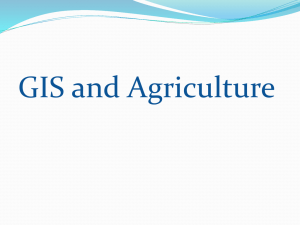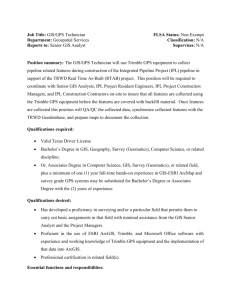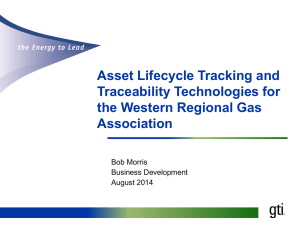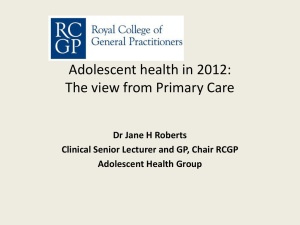Warren.Eisman.GIS.Part2
advertisement
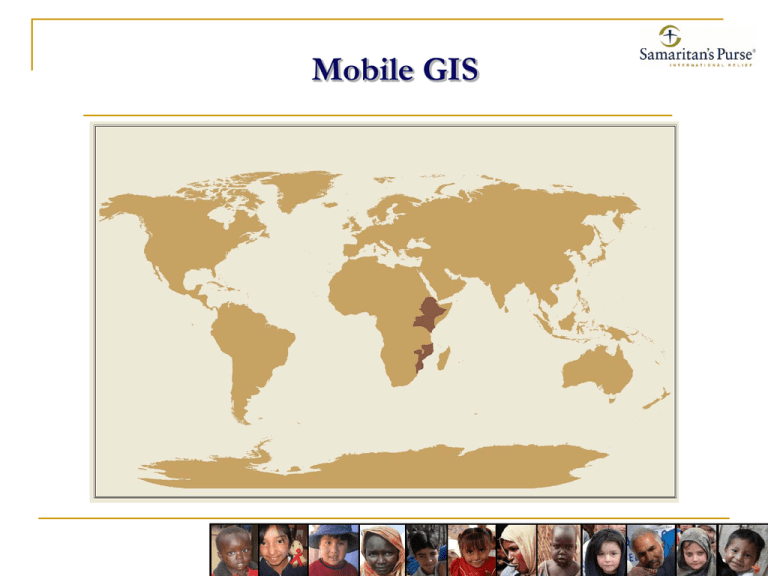
Mobile GIS Presentation Outline What is GIS\GPS and Mobile GIS? What we are looking for The Options GPS\GIS Demo with Survey Questions GIS – Geographic Information System A computer based system for: Capturing Storing Analyzing Querying Displaying Disseminating geographic data to provide a snapshot of reality. GPS – Global Positioning System •GPS is a worldwide radio-navigation system formed from a constellation of 24 satellites and their ground stations. •GPS uses these "man-made stars" as reference points to calculate positions accurate to a matter of meters or even centimeters with certain units •In a sense it's like giving every square meter on the planet a unique address. What is Mobile GIS? Mobile GIS is the use and collection of geographic data in the field on mobile devices Mobile GIS Components • Required • • • • • Hand-held computer Global Positioning System (GPS) GIS software and applications Spatial Data Beneficial • • Wireless communication network Server-side geographic analysis processing capabilities What we are looking for? Quick way to conduct survey Have data available quickly Keep track of historical data Compare and analyze data across different years Ease of use Low cost Spatial aspect (mapping) Options Paper Survey ( In use now) Laptop GPS Enabled laptop GPS Enabled pocket PC Smart Phone Paper Survey The Good • Easy to use • Not affected by technology issues The Bad •Stacks of paper •Time involves in data entry •Difficult to compare and analyze data •Data inaccuracy Laptop Computer The Good • Easy to use •Available •Can transfer data quickly between field and office The Bad •No GPS •Time involve in data entry •Difficult to compare and analyze data •Expensive •Battery life •Not for field use •Data inaccuracy GPS Enabled Laptop Computer The Good • Easy to use •Can transfer data quickly between field and office •GPS integrated •Integrated with GIS •Data already processed and ready to use. •Designed for field use The Bad •Heavy •Size •Very Expensive •Battery life GPS Enabled Pocket PC The Good •Easy to use •Can transfer data quickly between field and office •GPS enabled •Integrated with GIS •Data processed and ready to use •Rugged •Data Security •Windows mobile – Word, Excel, Email (outlook) •Easy to share with other organizations The Bad •Battery Life •Initial setup and development •Price GPS Enabled SmartPhone (Blackberry, iPhone) The Good •Easy to use •Can transfer data quickly between field and office using wireless network •GPS enabled •Can be integrated with GIS •Inexpensive hardware The Bad •Data security •Initial setup and development •Expensive data plans •Not designed for adverse conditions •The possibility of large phone bills Trimble Juno SB/SC Integrated 2-5m GPS 533MHz/128 MB RAM/128 MB Storage Integrated Bluetooth and Wireless Windows Mobile 6.1 Lowest Priced Trimble Unit Integrated Camera Optional Cellular ArcPad 8 • Customizable – interface and for other uses • Intuitive User Interface • GPS Capability • Collect and Edit Data in the Field Data Maintenance Cycle • • • Check Data Out • ArcGIS Desktop 3. Field to GIS 1. GIS to Field Data Collection • Feature Editing • Field Surveys Check Data In • Physically with ArcGIS Desktop 2. Field Update The workflow Demo and walk through of the process (Video) Expected Results Quicker data collection Quicker data integration Data available for analysis weekly The ability for the monitoring and evaluation of the project The ability to compare and contrast historical data Potential Problems Battery life Damage in the field Loss of data Questions?
